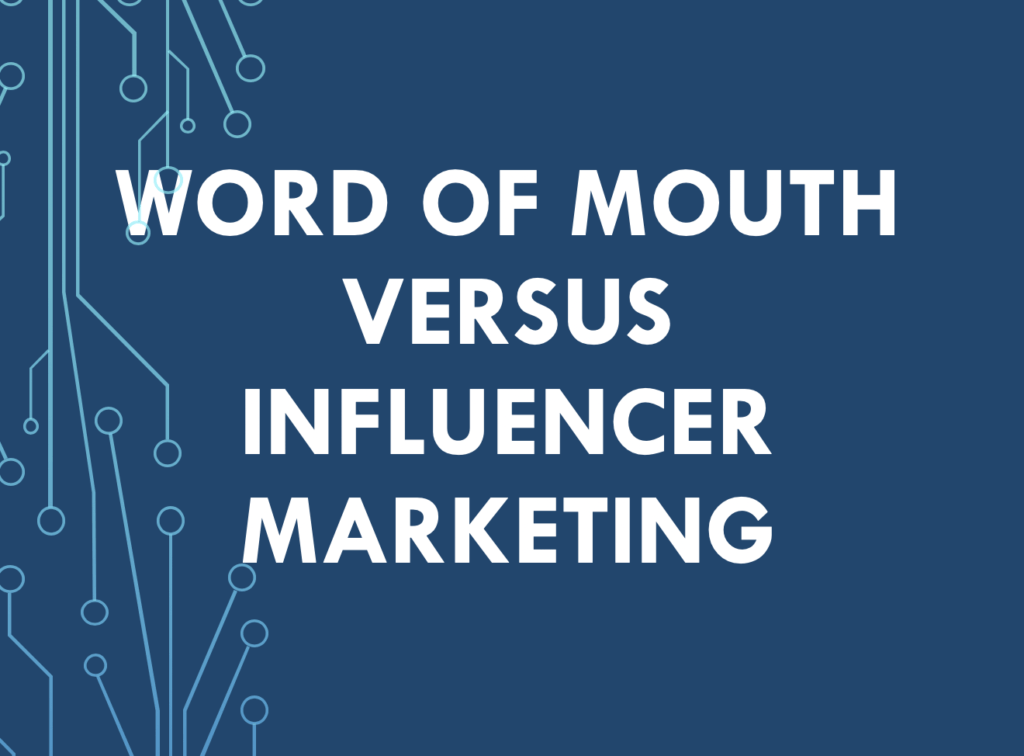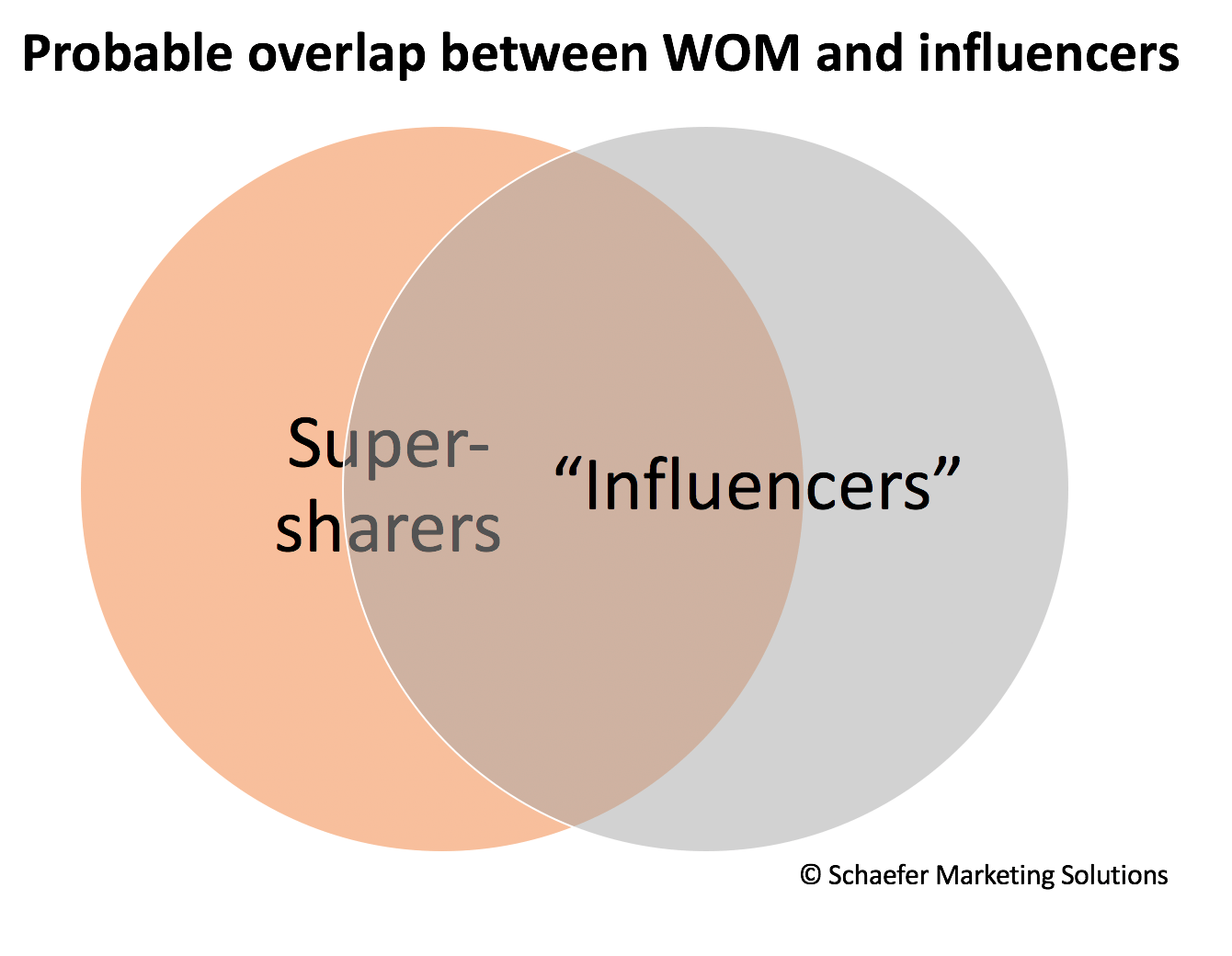
There has been a lot of attention lately on both influencer marketing and word of mouth marketing (WOMM). Are they the same? Not exactly. Today I’ll explore the differences, similarities, and opportunities of these two important strategies.
The goal
Both of these marketing methods are gaining traction and deservedly so — Edelman reports that trust in companies, brands and ads has dropped 10 years in a row. Who do people trust? Other people. So, let’s put marketing in the hands of those we trust — the basic philosophy of both tactics.
As I wrote in a recent post, my take on influencer/word of mouth is different from most. I think the goal for both tactics is simple: move your content. The economic value of content that is not seen and shared is zero, so it makes sense to find people who can spread content for us.
“Content” can be a story, an idea, a political philosophy. A product or service can even be conversational and therefore considered “content.”
Smart businesses know that helping our customers become our marketers — through Influencer marketing and WOMM — is an essential strategy.
There’s obvious overlap, but there are also differences between influencer marketing and word of mouth marketing
1) Relationships + reliability
In influencer marketing, there is normally a relationship (emotional or financial) between an organization and the person who is designated to spread the story. This assures some measure of accountability and reliability since the influencer has a dependable track record, a sense of obligation, and perhaps even trackable metrics. That dashboard-friendly security is appealing to many companies.
While some may think of influencers as YouTube stars shilling energy drinks, influencer marketing is a widespread practice across many industries, including B2B. An esteemed scientist, engineer, or business executive can be an influencer, too. Influencer marketing is even working its way down to small businesses and startups.

Keller
By contrast, WOMM is less dependent on relationships between a company and the people spreading a story. WOMM relies on seeding irresistible stories within relevant groups of strangers. Much of the theory behind WOMM stems from seminal research conducted by Ed Keller and his associates in the 1990s. Everybody is an influencer in some way, but Keller found that about 10 percent of the population are “super-sharers” (this is my own term I’ll use throughout this article to differentiate between WOMM and influencer marketing).
These super-sharers have “a greater than average reach or impact through word-of-mouth in a relevant marketplace.” They’re ordinary people, not celebrity actors or pro athletes.
If you provide these folks with an irresistible idea, they live to share those stories. The ideal story is authentic, relevant, and interesting. Focusing on that core story and getting it into the hands of relevant audiences is the heart of WOMM strategy.
You don’t need any relationship with super-sharers, but there is also no reliable obligation. It’s nearly impossible to observe and precisely record organic advocacy spreading quietly through communities of strangers.
2) Regulations
Influencer marketing has more regulatory burdens than WOMM in many countries. If an influencer is paid to promote a product, it must be disclosed as an advertisement. WOMM would be considered organic, authentic, and ad-free.
3) Value exchange
In WOMM, super sharers naturally pick up your story and joyfully spread it. With an influencer, the arrangement usually requires some value exchange – an experience, status, exclusive information, access to products, or even a paycheck.
Influencer marketing normally means “borrowing” the audience of somebody who has built an engaged following. Think of that audience as a valuable, tangible asset. You’ll have to provide an influencer with something to borrow that asset and leverage their hard-earned trust.
And naturally, as they move up the fame chain and acquire more followers (and more influence?), influencers demand greater compensation from brands for spreading the word about their product.
But that’s not always the case …
An important overlap
Ed Keller’s research would dictate that at least 10 percent of the “influencer” population would also be “super sharers” who organically share stories without any incentives:
However, it’s likely that in reality, this overlap is greater than 10 percent. My observation is that the super-sharer personality tends to migrate into the influencer category. To stay at the top of their field of expertise, influencers have to be in the know and maintain access to product and industry developments. It’s reasonable to assume that people who rise to “influencer” status also geek out about sharing new information just because it’s new, not because they’re paid.
It’s probable that more than 10 percent of the influencer population also fits Kellers’ definition of a super-sharer:
 There’s no formal test to determine who can be defined as an influencer or a super-sharer, so this is theoretical. The first chart is based on Keller’s data but the second chart is an estimate. The key idea is that WOMM and influencer marketing are joined at the hip. Both tactics are driven by people who love to transmit stories … and that is marketing gold.
There’s no formal test to determine who can be defined as an influencer or a super-sharer, so this is theoretical. The first chart is based on Keller’s data but the second chart is an estimate. The key idea is that WOMM and influencer marketing are joined at the hip. Both tactics are driven by people who love to transmit stories … and that is marketing gold.
Here’s an example of an influencer/super-sharer cross-over: Me.
For the many years, I was considered an influencer by Dell Technologies. I require a fair value exchange, but that usually is not in the form of money. I receive value from Dell through experiences like being invited to Dell World, access to executives, or opportunities to meet famous thought leaders (status).
I naturally talked about the company all the time. Why would I share stories without being paid? Because I authentically believe in the company and its people — and Dell constantly provides me with great experiences and interesting stories that are fun to share.
Am I a super-sharer? Am I an influencer? The answer is yes. I’m both. Sometimes I get paid, but I’m hardly a paid spokesperson for the company. There is never a script, a goal, or a metric on what I say or how I say it. I spread stories for the joy of it.
The authenticity blur
“Free” word of mouth will normally have an advantage over “paid” influencer marketing when it comes to authenticity. WOMM content transmission is friend-to-friend rather than influencer-to-friend.
However, I think the “authenticity gap” between influencer and super-sharer is blurring.
- Influencers (even when compensated) are regarded as trusted experts and friends — that’s why they’ve earned an audience in the first place. It’s a weird thing about our society. Fame equals trust.
- Research shows that paid sponsorships through content like podcasts are accepted and expected as part of the content format.
- Younger people accept paid influencer sponsorship as a way of life — “They’re my friend and they have to make a living.”
- A paid relationship with a beloved brand can actually add to the influencer’s authority and legitimacy. “Wow — she’s working with Adidas. She must be somebody I can look up to!”
The challenge of repetition
When I was in the corporate world, I was in charge of some massive change management projects (like adopting CRM!) I used to tell my staff that a person has to hear our message seven times before it is internalized.
Working that same message into an audience repetitively eventually impacts views, attitudes, and maybe even buying habits. So this is the challenge — and opportunity — with both of these marketing techniques. How do we get these peer-shared messages out repeatedly?
This is another difference between influencer marketing and word-of-mouth marketing. WOMM must be viewed as a long-term strategy with constant repetition of the message or story.
In general, influencer marketing tends to focus on short-term goals — a campaign — to promote a product (like a new movie). It doesn’t have to work that way (and I think it shouldn’t be that way!) but in general, that is the trend today.
In any event, there are opportunities to integrate repetition into either strategy to be effective.
Conclusion
WOMM and influencer marketing are both legitimate, important strategies in the post-advertising era. Increasingly the fields are blurring, but knowing the difference between influencer marketing and word of mouth marketing is important before executing any program.
 Mark Schaefer is the executive director of Schaefer Marketing Solutions. He is the author of some of the world’s bestselling marketing books and is an acclaimed keynote speaker, college educator, and business consultant. The Marketing Companion podcast is among the top business podcasts in the world. Contact Mark to have him speak at your company event or conference soon.
Mark Schaefer is the executive director of Schaefer Marketing Solutions. He is the author of some of the world’s bestselling marketing books and is an acclaimed keynote speaker, college educator, and business consultant. The Marketing Companion podcast is among the top business podcasts in the world. Contact Mark to have him speak at your company event or conference soon.
Follow Mark on Twitter, LinkedIn, YouTube, and Instagram.
Illustration courtesy Unsplash.com


